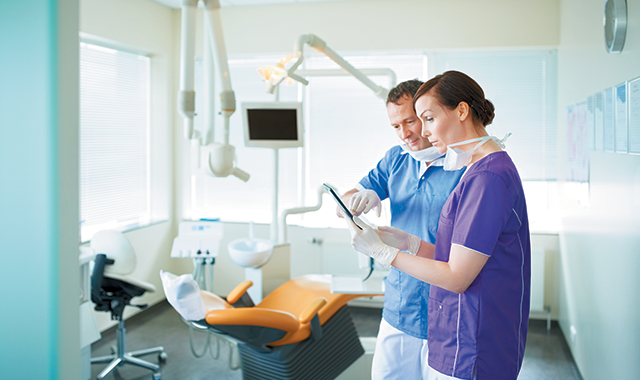Why hygienists should be familiar with periodontal plastic surgery techniques
From fixing gummy smiles to concerns about gum recession, more dental patients are requesting periodontal plastic surgery for esthetic and functional purposes.

A beautiful 18-year-old female came bouncing into my operatory yesterday. She was beaming as she talked about starting college. She was a new patient and her mom accompanied her to the appointment. Her mom was a patient of a local periodontist and the main reason for their visit was a concern about gum recession in the mandibular anterior sextant. The patient was scheduled to see me first, before seeing the dentist, and I was excited to take a peak.
The denuded presentation was fairly typical and involved an aberrant frenum, a shallow vestibule, and a lack of an adequate band of attached gingiva on the facial surfaces of teeth #24 and #25. She told me it was very sensitive to the touch and she was trying to keep it biofilm-free.
Periodontal plastic surgery
Over the years, I’ve had several successful mucogingival surgeries, one an epithelialized palatal graft and two subepithelial connective tissue grafts. Grafts were performed by periodontists, one of whom was a periodontist-employer. These surgeries were performed to cover denuded multiple surfaces of anterior and premolar teeth.
More from the author: Hygiene instrumentation shorcuts: are they wise?
Mucogingival surgeries evolved in the late 1950s and were designed to deepen the vestibule, correct an aberrant frenum and create keratinized tissue. In 1988, PD Miller Jr. presented a new definition of functional mucogingival surgeries to include esthetics and he defined it as “surgery to correct anatomical, developmental or traumatic deformities of the gingiva and alveolar mucosa.” He referred to these mucogingival surgeries as periodontal plastic surgery.1 Periodontal plastic surgery produces a functional and esthetic result whereas the early mucogingival surgeries focused more on function.1 According to Dr. Miller, the term “mucogingival surgery” is antiquated and dated over 30 years.1
In reviewing Dr. Miller’s online textbook (which is available for everyone to read), I noticed that he suggested revising the names of commonly performed periodontal plastic procedures to better reflect more accurately the procedure being performed. For example, the term “altered passive eruption” may be better described as “excessive gingival display” and the rationale is an esthetic one. Altered passive eruption is also referred to as a “gummy smile.” RDHs can learn a lot from listening to Dr. Miller’s lectures on his web textbook.
The Chao Pinhole® Surgical Technique (PST)
A general dentist named John C. Chao, DDS, is the inventor of the PST periodontal plastic surgery technique, which Dr. Chao describes as a “scalpel-free, suture-free procedure for correcting gum recession.”2 The technique is further described as follow:
“Through a small hole made by a needle, Dr. Chao uses specially designed instruments to gently loosen the gum tissue and glide it over the receded part of the tooth. Since there is no cutting or stitching, patients can expect minimal post-operative symptoms (pain, swelling and bleeding). Most patients also are pleasantly surprised by the instant cosmetic improvement.”

On Dr. Chao’s website, there’s a YouTube video that accompanies the written description of the procedure.2 According to Dr. Chao’s staff, roughly 3,000 practitioners worldwide have been trained to perform PST at the Pinhole Academy, including 800 periodontists, 2,100 general dentists and 100 miscellaneous specialists like prosthodontists.
The biggest advantage to patients in choosing this particular technique over others is that it’s an option to grafting; however, it’s not for every patient and is mostly performed on Miller Class I and II recession defects. (For a review of Miller classifications, click here.) Dr. Chao also reports success with 40-50 percent of Class III recession defects, but a periodontist I spoke to who’s certified to perform PST only recommended this procedure for Class I and Class II recession defects. PST requires very expensive instruments that are purchased by course participants.
Trending article: 6 ways to help patients overcome fear of the dentist
Selection of surgical techniques by an appropriate surgeon is case dependent and dictated by the anatomy of the defect site, size of the recession defect, presence or absence of keratinized tissue adjacent to the defect, the width and height of the interdental soft tissue, and the depth of the vestibule or the presence of frenula.4 There are also esthetic considerations, patient preferences and the evidence-based predictability of various surgical techniques to be evaluated.4
Studies to compare PST to subepithelial connective tissue grafts and other grafting techniques are non-existent, so we don’t yet have technique comparison data such as cost comparisons and long-term outcomes. I found only one clinical study, authored by Dr. Chao, which was a small (N=43) practice-based study (121 recession sites: 85 Class I and Class II and 36 Class III).3 In this study, the PST procedure was performed by Dr. Chao in his dental practice. Dr. Chao reports 81.2 percent predictability of PST for Class I and Class II sites when measured as a frequency of complete root coverage, and he indicates that PST holds promise as a minimally invasive surgical technique.3
It’s always important to have a periodontist on your team whenever possible. Periodontists have undergone an extra three years or more of specialized training in order to successfully provide periodontal plastic surgery procedures. They spend countless hours in continuing education and patient care just as medical specialists do. Schedule a lunch-and-learn with a local periodontist and chat about the various periodontal plastic procedures, including PST.
And if you were wondering - The 18-year-old patient with denuded root surfaces in the mandibular anterior sextant was referred to a local periodontist for assessment and treatment.
References:
1. https://pdmillerswebtextbook.com/2017/11/21/the-evolution-of-mucogingival-surgery-to-periodontal-plastic-surgery/
2. https://www.pinholesurgicaltechnique.com
3. Chao JC. A novel approach to root coverage: the pinhole surgical technique. Int J Periodontics Restorative Dent 2012; 32:521-531.
4. Alghamdi H et al. Surgical management of gingival recession: a clinical update. Saudi Dent J. 2009 Jul; 21(2): 83–94.